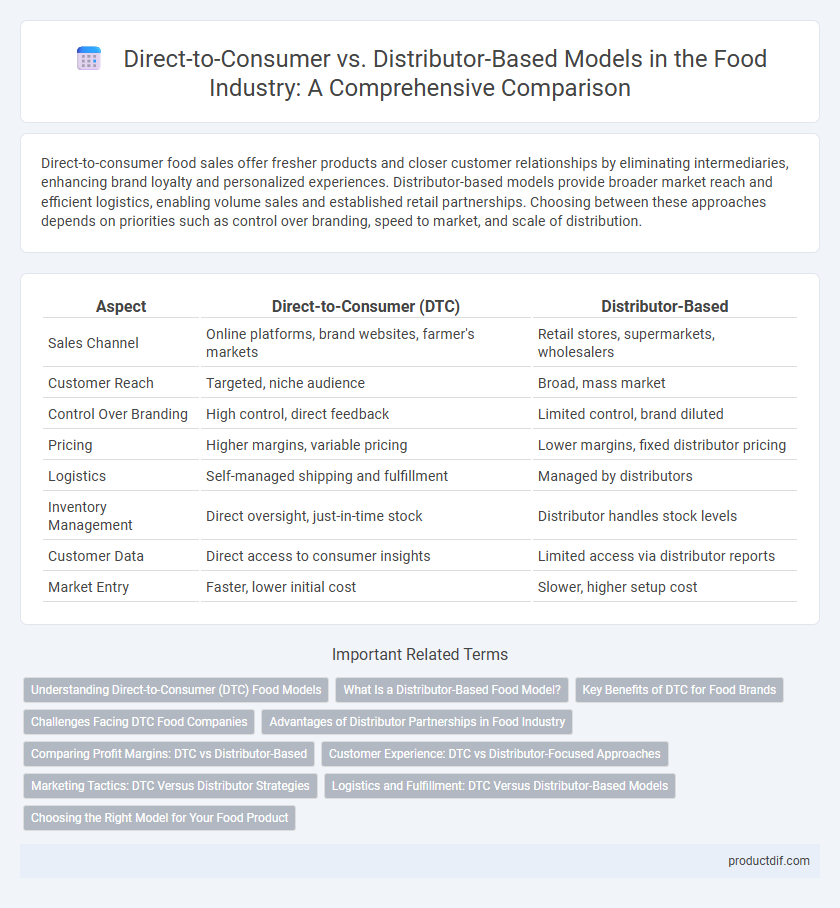Direct-to-consumer food sales offer fresher products and closer customer relationships by eliminating intermediaries, enhancing brand loyalty and personalized experiences. Distributor-based models provide broader market reach and efficient logistics, enabling volume sales and established retail partnerships. Choosing between these approaches depends on priorities such as control over branding, speed to market, and scale of distribution.
Table of Comparison
| Aspect | Direct-to-Consumer (DTC) | Distributor-Based |
|---|---|---|
| Sales Channel | Online platforms, brand websites, farmer's markets | Retail stores, supermarkets, wholesalers |
| Customer Reach | Targeted, niche audience | Broad, mass market |
| Control Over Branding | High control, direct feedback | Limited control, brand diluted |
| Pricing | Higher margins, variable pricing | Lower margins, fixed distributor pricing |
| Logistics | Self-managed shipping and fulfillment | Managed by distributors |
| Inventory Management | Direct oversight, just-in-time stock | Distributor handles stock levels |
| Customer Data | Direct access to consumer insights | Limited access via distributor reports |
| Market Entry | Faster, lower initial cost | Slower, higher setup cost |
Understanding Direct-to-Consumer (DTC) Food Models
Direct-to-consumer (DTC) food models enable producers to sell products directly to customers through online platforms, bypassing traditional distributors and retailers. This approach allows for greater control over branding, pricing, and customer engagement while often resulting in fresher products delivered straight from farm to table. Increased demand for transparency and personalized shopping experiences drives the growth of DTC food channels in competitive markets.
What Is a Distributor-Based Food Model?
A distributor-based food model involves manufacturers selling products through third-party distributors who manage logistics, storage, and delivery to retailers or foodservice providers. This model enables wider market reach and volume sales by leveraging established distribution networks and relationships with grocery stores, restaurants, and other food outlets. It often results in reduced direct customer interaction but allows producers to focus on manufacturing efficiency and brand development.
Key Benefits of DTC for Food Brands
Direct-to-consumer (DTC) models enable food brands to build stronger customer relationships through personalized marketing and direct feedback channels, enhancing product development and satisfaction. DTC eliminates distributor markups, increasing profit margins and allowing competitive pricing while maintaining brand control over the customer experience. Leveraging e-commerce platforms, food brands can rapidly test new products, gather valuable consumer data, and optimize inventory management without dependency on third-party distributors.
Challenges Facing DTC Food Companies
Direct-to-consumer (DTC) food companies face challenges such as high customer acquisition costs, complex logistics, and maintaining product freshness during shipping. Managing inventory and navigating regulatory compliance across multiple regions also strain resources. These obstacles contrast with distributor-based models, which leverage established networks but sacrifice direct customer relationships.
Advantages of Distributor Partnerships in Food Industry
Distributor partnerships in the food industry enhance market reach by leveraging established logistics networks and retail relationships, enabling faster product delivery and wider shelf presence. These partnerships reduce operational complexities and allow manufacturers to focus on product innovation and quality control. Access to distributor expertise in regulatory compliance and market trends further ensures efficient entry and sustained growth in competitive food markets.
Comparing Profit Margins: DTC vs Distributor-Based
Direct-to-consumer (DTC) food brands typically enjoy higher profit margins by eliminating intermediaries, allowing them to capture the full retail price and maintain control over pricing strategies. Distributor-based models incur additional costs from wholesalers and retailers, which reduce overall profit margins despite potentially larger sales volumes. Leveraging DTC channels enables food producers to optimize margins through direct customer relationships, personalized marketing, and streamlined supply chains.
Customer Experience: DTC vs Distributor-Focused Approaches
Direct-to-consumer (DTC) food brands offer personalized shopping experiences, immediate customer feedback loops, and greater control over product presentation, enhancing brand loyalty and satisfaction. Distributor-based models expand market reach and availability but often dilute the direct interaction and customization opportunities, potentially leading to less personalized customer service. The DTC approach excels in creating tailored experiences and transparency, whereas distributor-focused strategies prioritize broad accessibility and supply chain efficiency.
Marketing Tactics: DTC Versus Distributor Strategies
Direct-to-consumer (DTC) marketing tactics leverage personalized digital campaigns, social media engagement, and data analytics to build direct relationships and increase customer lifetime value. Distributor-based strategies prioritize broad market reach through retailer partnerships, in-store promotions, and trade shows to enhance product visibility and shelf placement. DTC allows brands to control messaging and pricing, while distributor strategies rely on established networks to scale distribution rapidly.
Logistics and Fulfillment: DTC Versus Distributor-Based Models
Direct-to-consumer (DTC) food brands manage their own logistics and fulfillment, enabling greater control over inventory and faster delivery times tailored to customer demand. Distributor-based models rely on third-party logistics and wholesale networks, which can extend reach but often result in longer lead times and less direct oversight of inventory management. Efficient supply chain coordination and real-time tracking systems are critical in both models to ensure product freshness and timely order fulfillment.
Choosing the Right Model for Your Food Product
Direct-to-consumer (DTC) models offer food producers higher profit margins and direct customer feedback, enabling tailored product development and brand loyalty. Distributor-based models provide extensive market reach and streamlined logistics, ideal for scaling and entering diverse retail channels quickly. Selecting the appropriate model depends on factors such as production capacity, target audience, marketing strategy, and long-term growth objectives within the competitive food industry.
Direct-to-consumer vs Distributor-based Infographic

 productdif.com
productdif.com